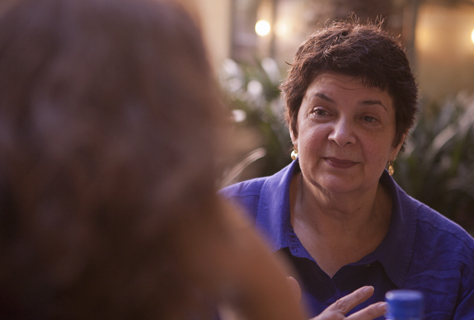24.07.2014 - 14:27
Mary Ann Newman (New York, 1951) is a translator, writer, and promoter of culture. She defends the term “Catalanist” to describe herself, in the dictionary sense (“someone who studies the Catalan language and culture”). She is a member of the board of the North American Catalan Society, which gives her a broad perspective on Catalan studies in the United States. Without Mary Ann Newman, one cannot understand the first Barcelona – New York Chair (1983-1986), initiated by the Barcelona City Government and New York University, or the Catalan Center (2007-2011) tied to the Institut Ramon Llull and New York University. In both the academic and personal spheres, Mary Ann Newman has always been committed to constructing bridges of culture between Barcelona and New York, between Catalonia and the United States. Her latest initiative is the Farragut Fund for Catalan Culture in the US (Fons Farragut), a non-profit whose goal is to promote culture, cultural interchange, and intercultural projects of the Catalan Countries in the United states, based on the philanthropic traditions of American and Catalan businesses. It’s a project full of good ideas, especially for Catalan culture, and which seeks to maximize the country’s assets. Let’s take a look.
Now that Americans are beginning to understand Catalonia as a country, you have begun an exciting project, that goes beyond culture and academia and which involves private enterprise. What is the Farragut Fund about?
Like a good American, daughter of a country where philanthropy is a true “terciary sector”, which works beyond the public and private spheres, for a long time, I’ve had it in my head that we should go further than the institutional funds that come from the Catalan Government and look for private monies in order to promote the exchange of culture between our two countries. This is where the Farragut Fund for Catalan Culture in the US came from. The vision, that is, the objective, is to have a strong, visible, generous presence of Catalan culture in the United States. We are a non-profit organization that looks for donations that will ensure the permanent presence of Catalan culture among the mosaic of American cultures and which directs those monies toward projects that achieve the objective. And that has an important advantage, because it’s contributing to the development of an influential community of Catalan culture in the United States. There are many illustrious Catalans living in the US that have no current relationship among themselves. There are also many Americans who know and appreciate Catalonia but who don’t know each other. If this whole collective can come together around a cultural project realted to Catalonia, it automatically becomes a powerful lobby. And all of that can help encourage the philanthropic spirit that Catalans and Americans generally share.
What do you mean by philanthropy?
Philanthropy is not the same as sponsorship. Philanthropy is done in the spirit of giving back and of having a positive effect on society; it has a transformative goal, not a charitable one, it’s not just a donation. This spirit of transforming civil society in the United States is recognized by the government, since donations can be deducted from up to 10% of one’s taxes. Therefore, we want to get Catalan companies involved who are established in the US so that they can also benefit from the tax benefits and become part of the philanthropic networks, who gather together veritable titans of society and business. And we also want to establish relationships with US businesses with offices in Catalonia so that they can also demonstrate an appreciation for the Catalan culture that has welcomed them.
What advantages does this offer Catalan businesses in the United States?
If the American subsidiaries of Catalan businesses donate money for cultural projects tied to Catalonia, this has multiple advantages: visibility and networking in the US and credit and prestige in Catalonia for having promoted Catalan culture abroad. Catalan culture in the United States is increasingly well-known and highly valued. So, an association with Catalan culture is an association with high quality at the same time as the Catalonia brand is strengthened.
Why did you name the foundation “Farragut”?
It’s called Farragut, in the first place, to honor the Farragut family: Jordi Farragut i Mesquida, who emigrated from Menorca to New Orleans in 1776, via Barcelona, and who fought in the War of American Independence. Farragut is known as a hispanic hero and nobody knows he had Catalan, Menorcan origins. Even fewer know that about his son, David Farragut, the first admiral in the United States Navy and a hero of the US Civil War. In the United States, there is a lot of unknown Catalan heritage, often because many Catalan personalities are labeled as Spanish: Rafael Gustavino, who was Valencian, Gaspar de Portolà, governor of California, born in Balaguer, the Miquelets who went to California, and so on and so on, up to and including Joan Miró, Salvador Dalí and others. On the other hand, there is the intangible Catalan heritage, for example, the Mediterranean diet.
What do you plan to do with the Mediterranean diet?
There’s this idea of promoting Mediterranean Diet Year in the US and that the host be Catalonia. Because the Catalan model of the Mediterranean diet is so compact and elegant that it makes it easy to explain, for example, how in a Mediterranean city the market continues to be a central anchor for the neighborhood, among other things. As a host, Catalonia can invite other countries in the Mediterranean to join the project: we could follow the history of the chick pea through Egypt, Israel, Italy, Greece, and observe how it is used and eaten in each country. Or olives and olive oil. It’s a way of looking at Catalan culture in a broader context. But Farragut doesn’t organize events, it only serves as a catalyst, by locating the funds and the collaborators: US organizations that can bring them to life.
Do the objectives of the Farragut Fund go beyond spreading Catalan culture?
Yes. In addition to preserving and promoting Catalan heritage, there is the possibility of exchange programs to enable the development of cultural projects. So that whoever wants to go to the US to undertake a project, be it for three or six months, to develop a play or an artistic show, under the tutelage of a cultural institution from there, should be able to do so. And the Americans who want to come to Catalonia to do the same thing should also have the chance. We don’t organize anything, we just link projects with the institutions that might be able to support them.
Often that’s the most difficult part.
Maybe so, but we have a whole slew of groups who are interested, and in the United States if it’s a good idea, and there is money behind it, it’s not very often that they’ll tell you no. The third objective, together with heritage and exchange are serious intercultural projects, like 2014’s Year of Catalan Architecture (which includes a Guastavino exhibition as well as one on the Sagrada Família), or Enric Granados Year in 2016, on the 100th anniversary of the musician’s death. (A US committee has been working on it for two years.)
Two years ago you began to work on the Farragut Fund and last year you made it official. Who are the principal patrons of this non-profit?
The board consists of three people: Marcel Molins, Ferran Escayola and John Casey, two very prestigious lawyers and one professor of Public Administration from Baruch College who specializes in philanthropy. The members of the initial board have shepherded the entire process of creating the legal structure and have given the project the green light. The next step is to expand the board with people from the business community in order to create an executive advisory council.
What will be your role?
I am the executive director of the Farragut Fund. And I believe that one of the most important things that we can offer Catalonia, which can help build this network of influence, is that we can serve as a platform for Catalan foundations who want to have one foot in the US without having to establish a foundation there. We’re talking about signing an agreement with the Fundació Abadia de Montserrat and the Fundació Victòria de los Àngeles. We have already signed an accord with the Fundació Mies van der Rohe, under the auspices of the Barcelona City Government. And out of that relationship came the “Barcelona-New York City Urban Bridge 2014: A Year of Catalan Architecture in New York” with US partners like the Center for Architecture-AIANYH, the Museum of the City of New York and the City College Spitzer School of Architecture.
Is this the first project that makes the Farragut Fund visible?
Yes. This project came about because this 2014 at the Museum of the City of New York they opened an exhibit on the work of the Guastavinos in the United States. New York is the city that has the highest concentration of buildings by these two architects (father and son): more than 250 buildings or installations (and almost 700 throughout the whole country). The Museum of the City of New York has taken the responsibility of reflecting this fact. But there were additional circumstances, the most important of which was that in 2014 the president of the American Institute of Architects-New York is Lance Jay Brown, who is an admirer of Barcelona, of Catalonia, and of the Catalan Countries (who in 1964 built a house on the Balearic island of Formentera where his daughter lives to this day with Brown’s new grandchild), and who made the BCN-NYC Urban Bridge 2014 – Year of Catalan Architecture in New York one of the central pillars of his presidency.
How is the Year of Catalan Architecture in New York structured?
The three pillars are the Guastavino exhibition, which will last from March to September; the Sagrada Família exhibition at the CCNY Spitzer School of Architecture, which will open in the fall; and all of the other exhibits related to Catalonia held at the Center for Architecture-AIANY: “Polis: 7 lessons about urban public space” at the CCCB gathers the ideas that have come out of the last 10 years of European prizes for urban public space projects, and “Barcelona Glòries. Dialogue and Transformation” explains the transformation of the Plaça de les Glòries. Last week, the Center for Architecture hosted a very interesting gathering to contrast—against a backdrop of new visions for public space—Barcelona’s Glòries project with the transformation of Times Square and the Hudson Yards project. Hudson Yards was where trains were stored when not in service, next to the Hudson River, and now it is a new urban focal point. Barcelona’s vice mayor Antoni Vives and the architect Maria Sisternas gave a presentation with the new commissioner of the New York City Department of Design & Construction, Dominican-born engineer, Feniosky Peña-Mora. I tweeted the whole conversation, a fascinating exchange, in which everyone (and that includes all of the architects and urban planners in the audience) agreed that the two cities have important things to teach to and learn from each other.
Other projects?
Within the Year of Catalan Architecture in New York there could be an exhibit about the Born, thanks to the Tricentennial and to a view of the city through this historic prism. But we hope to go beyond architecture. Everything is possible! Any aspect in which Catalan culture is highlighted can be featured. For example, lesser-known languages and cultures. That—lesser-known language—is a real category in the United States! Multicuturalism, which is as important here as there, makes it possible to contextualize Catalan culture in the most broad way possible. Or other aspects of the Mediterranean sphere: about poetry or dance. Catalan culture has many facets left to explore, and the US will receive them with respect and interest, and the ties between the two will be interesting. The Toy Museum surely has many hidden allies in the US, that of Cinema as well; and the Rural World Museum. The possibilities are wide open.
The Barcelona Glòries. Dialogue and Transformation conversation that Newman tweeted is reproduced below:



